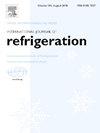Theoretical investigation on the performance of R600/R170/R14/R50 four stage regenerator-enhanced auto cascade refrigeration system
IF 3.5
2区 工程技术
Q1 ENGINEERING, MECHANICAL
International Journal of Refrigeration-revue Internationale Du Froid
Pub Date : 2025-02-14
DOI:10.1016/j.ijrefrig.2025.02.004
引用次数: 0
Abstract
In multi-stage auto cascade refrigeration (ACR) systems, the component selection and ratio optimization of zeotropic mixed refrigerants is important. A four-stage regenerator-enhanced ACR (RACR) system using R600/R170/R14/R50 was proposed. Influences of refrigerant mixture ratio, high-boiling-point components, gas-phase fraction before throttling (x4) and gas-liquid separation temperature (TS1∼TS3) on the system performance were explored. Exergy loss ratios of components were compared and analyzed. The results demonstrated that increasing the mass fraction of R170 and reducing that of R50 significantly improve the energy efficiency, and reduce discharge temperature. To obtain -140 °C, a minimum x4 (x4 min) could optimize the coefficient of performance (COP). R600/R170/R14/R50 (mass fraction of 0.38/0.20/0.17/0.25 and x4 min of 0.12) had the best COP of 0.192 and exergy efficiency of 0.330 under variable x4 conditions. To improve the energy efficiency, appropriately reducing TS1 and TS3, or increasing TS2 could be adopted. The top three components in the RACR system accounted for the largest exergy loss proportion were compressor, throttle at the evaporator inlet and condenser, accounting for 26.0 %, 18.3 % and 15.7 %, respectively.
R600/R170/R14/R50四级蓄热器增强型自动复叠制冷系统性能的理论研究
在多级自动串级制冷(ACR)系统中,共沸混合制冷剂的组分选择和配比优化是一个重要问题。提出了一种以R600/R170/R14/R50为基料的四级蓄热器增强型ACR (RACR)系统。考察了制冷剂混合比、高沸点组分、节流前气相分数(x4)和气液分离温度(TS1 ~ TS3)对系统性能的影响。对各部件的火用损失率进行了比较和分析。结果表明,提高R170的质量分数,降低R50的质量分数,可以显著提高能效,降低排气温度。为了获得-140°C,最小x4 (x4 min)可以优化性能系数(COP)。在可变x4条件下,R600/R170/R14/R50(质量分数为0.38/0.20/0.17/0.25,x4 min为0.12)的COP为0.192,火用效率为0.330。为提高能效,可适当降低TS1和TS3,或提高TS2。RACR系统中火用损失比例最大的前3个部件分别是压缩机、蒸发器进口节流阀和冷凝器,分别占26.0%、18.3%和15.7%。
本文章由计算机程序翻译,如有差异,请以英文原文为准。
求助全文
约1分钟内获得全文
求助全文
来源期刊
CiteScore
7.30
自引率
12.80%
发文量
363
审稿时长
3.7 months
期刊介绍:
The International Journal of Refrigeration is published for the International Institute of Refrigeration (IIR) by Elsevier. It is essential reading for all those wishing to keep abreast of research and industrial news in refrigeration, air conditioning and associated fields. This is particularly important in these times of rapid introduction of alternative refrigerants and the emergence of new technology. The journal has published special issues on alternative refrigerants and novel topics in the field of boiling, condensation, heat pumps, food refrigeration, carbon dioxide, ammonia, hydrocarbons, magnetic refrigeration at room temperature, sorptive cooling, phase change materials and slurries, ejector technology, compressors, and solar cooling.
As well as original research papers the International Journal of Refrigeration also includes review articles, papers presented at IIR conferences, short reports and letters describing preliminary results and experimental details, and letters to the Editor on recent areas of discussion and controversy. Other features include forthcoming events, conference reports and book reviews.
Papers are published in either English or French with the IIR news section in both languages.

 求助内容:
求助内容: 应助结果提醒方式:
应助结果提醒方式:


